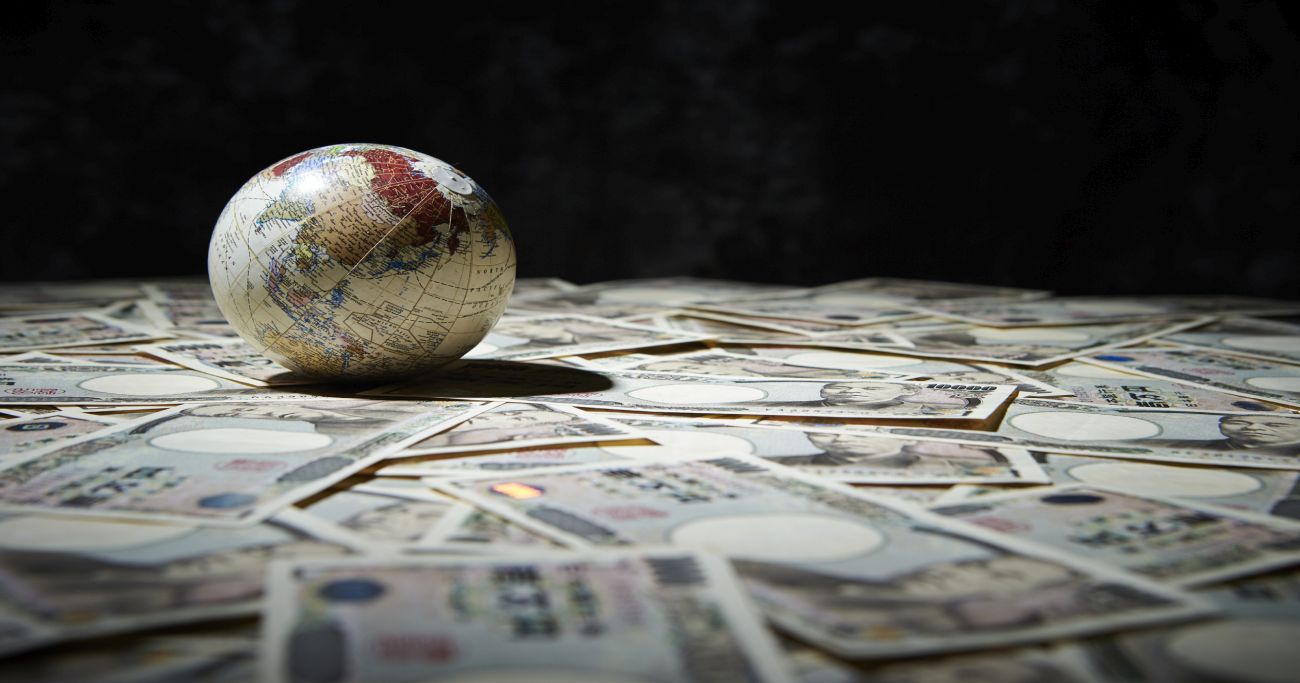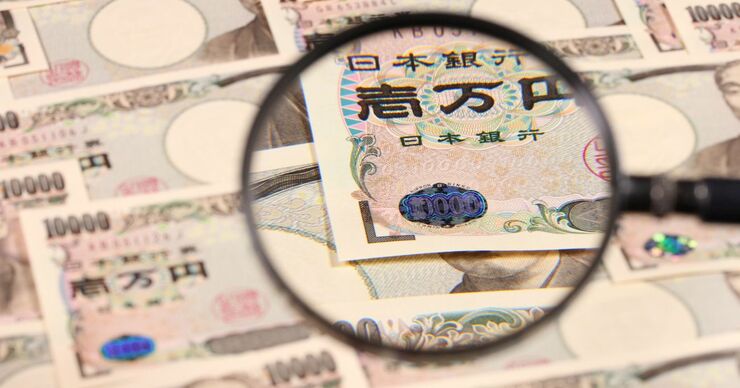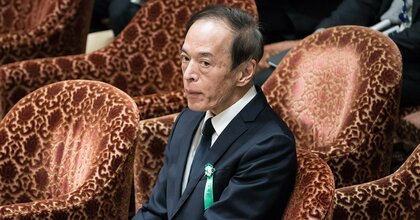Originally published in Japanese on Apr. 21, 2023
Global concerns
Ueda also mentioned that distortions in the Japanese government bond (JGB) market had been corrected since last month due to a decline in Japan's long-term yield triggered by banking sector problems in the United States and Europe and the associated decline in those yields. He implied that the sustainability of yield-curve control had improved.
Ueda repeated, "If the underlying inflation rate does not rise toward 2% stably, monetary easing will be prolonged by taking into account the side effects and developing a more sustainable monetary easing mechanism." However, he did not clarify at either his Diet confirmation hearing or his inaugural press conference whether this refers to an expansion of the 10-year yield target, like that which the BOJ implemented last December. This ambiguity will be an issue in future dialogue with the market.
The global economic conditions surrounding Japan have been unfavorable this year. There is a growing concern about a global economic slowdown, partly due to heightened geopolitical risks and partly due to previous monetary tightening effects worldwide. In the United States, the bankruptcy of Silicon Valley Bank last March triggered an outflow of deposits from regional banks and heightened concerns about financial stability.
Concerns remain that higher funding costs for banks and a tighter lending stance toward borrowers will put downward pressure on U.S. economic activity. In Europe, the bankruptcy of Credit Suisse in Switzerland has also raised concerns about a deterioration in the financial environment. Regarding China, the removal of the zero-COVID measures late last year has generated expectations for a significant economic recovery, but so far, the recovery of consumption and housing investment remains sluggish. In these global conditions, Japan is also facing a deterioration in business confidence and sluggish industrial production, especially in the manufacturing industry.
Even though it is unlikely that stable 2% inflation will be achieved soon, there is strong market speculation that the BOJ will make an early policy shift, including the removal of the control of the 10-year yield this year. There are two possible reasons for this view. One is that the inflation rate hit 3.3% this February (3.2% excluding fresh food, 3.4% excluding fresh food and energy, and 2% excluding food and energy), well above the 2% price stability target. As a result of the government's measures to cope with rising prices, the increase in electricity bills has largely stopped since this February. However, inflation remains high because 60% of inflation is due to soaring food prices.
Excluding food, the inflation rate remains in the 1% range, and upward pressure on food prices is likely to weaken gradually over time. There is a possibility that the inflation rate will fall below 2% toward the end of this year. This will create a high hurdle for the BOJ, which has stuck to the 2% price stability target, to reverse its monetary easing stance next year, especially when inflation of below 2% becomes more prevalent.
Another reason is that central banks globally are approaching the end of rate hikes. The U.S. Federal Reserve is expected to raise the federal funds rate by 25 basis points to 5% to 5.25% at the next meeting of the Federal Open Markets Committee in May, which will likely be the terminal rate. The market expects an interest rate cut as early as September this year due to growing concerns about an economic slowdown in the United States. If that happens, the interest rate differential between the United States and Japan (including forecasts) will shrink, so the yen, which is currently around 130 yen to the dollar, is likely to appreciate. The longer the reversal of monetary easing is delayed, the higher the risk that the yen will appreciate even further, hitting exporters accordingly.
In this column, I will look more closely at trends in the Japanese economic structure, the labor shortage and output gap relationships, and the feasibility of achieving the demand-driven 2% inflation target. Moreover, I will touch on the pros and cons of creating surprises when making monetary policy decisions.
Sluggish demand, low growth
Looking at the Japanese economy in the overview, it is clear that the economic recovery has become quite sluggish. This is because there has not been enough productivity improvement and technological innovation to counteract the downward pressure of aging on the economy. Real gross domestic product (GDP) fell sharply in many countries due to the COVID-19 pandemic in 2020, but the subsequent rebound was strongest in the United States, followed by Europe. Among major developed countries, Japan was the least resilient.
The real GDP level has not yet returned to the pre-COVID level of early 2019. Last year, a strong economic recovery was expected in Japan due to the phased abolition of mobility restrictions and border measures to address the pandemic, but the quarterly economic growth rates alternated between positive and negative, achieving a mere 1% growth for the full year. This year is likely to see a similar 1% growth.
Over the past 10 years (2013-2022) of unprecedented monetary easing under former BOJ Governor Haruhiko Kuroda, the average real economic growth rate was only 0.5%, and the 10 years before that (2002-2012) saw just 0.7% (see chart). Over the last two decades, Japan's growth rate has been low, in line with its low potential growth rate. The main reasons for the low potential growth rate were the declining working population and the expansion of employment driven by an increase in non-regular employment (mostly short-time workers comprised of housewives and senior citizens). In addition, companies increased capital investment in renewal investment, labor-saving investment, and digitization investment, but the increase was not strong enough to expand the capital stock. Growth in total factor productivity was also sluggish and did not significantly outpace the sluggish increase in capital stock.

Labor shortages and output gaps
With such a low potential growth rate and weak domestic demand (such as consumption and capital investment), it will be difficult to achieve the 2% inflation target. Even if the output gap becomes positive—most likely due to labor shortages—it will be very difficult to achieve 2% inflation stably if the potential growth rate and the increase in domestic demand remain sluggish. Additionally, it is clear from the experiment of the past 10 years that it is difficult to create domestic demand through monetary easing alone, as the new BOJ governor admitted.
Therefore, the government is trying to take the initiative and implement measures to stimulate domestic demand. Globally, investment is picking up with the aim of achieving carbon neutrality by 2050 or somewhat later. The Japanese government has set a goal of achieving approximately 150 trillion yen ($123.7 billion) in investment through public-private partnerships over the next 10 years, a scale comparable to that of Europe and the United States. Of that amount, the government will issue GX (green transformation) bonds totaling 20 trillion yen. Up to 1.6 trillion-yen equivalent bonds will be issued in fiscal 2023, and the issuance of bonds will continue every year for 10 years. The remaining private capital investment will be about 130 trillion yen or 13 trillion yen annually.
It should be noted that companies spent 94 trillion yen on capital investment last year. Since this includes the soaring cost of raw materials, however, the amount was about 89 trillion yen in real terms. The real growth rate of business fixed investment averaged 1.3% from 2013 to 2022, compared with 0.7% in the decade before that. Since these levels of investment growth were not large enough to raise the potential growth rate, companies this time had to expand fixed investment significantly to raise Japan's potential growth rate.
How much "additional" investment corporate GX investment will bring depends on the companies' growth strategies and their ability to execute them. Given GX investment is conducted in many countries and global competition has intensified, it is uncertain whether Japanese companies will risk an additional annual investment of about 13 trillion yen. Indeed, China's clean investment in 2020 was the world's largest, doubling that of the United States in second place and 10 times that of Japan.
What about household consumption? The government has emphasized the need to invest in human resources, raise wages for nursing and childcare workers (to attract and maintain employment), and raise minimum wages. Companies have also been urged to raise wages, and financial support has been provided for child-rearing and low-income earners. These efforts are expected to increase households' wages and income, leading to an increase in consumption. However, there is still a deep-rooted tendency toward saving in Japan due to concerns about longevity and the sustainability of social security systems. It is not clear to what extent government efforts to increase income will lead to sustainable consumption. In addition, it will be difficult for workers to form expectations of sustained wage increases unless they feel that their companies will continue to become more profitable and productive going forward.
While Japan's inflation rate is expected to gradually fall below 2% toward the end of this year, inflation will likely be higher than before the COVID-19 pandemic. This is because general prices may continue to rise due to supply-side or external factors, including labor shortages, rising production costs in China, and the resultant homeshoring of production bases due to geopolitical risks, the continuation of infectious diseases, the Ukraine war, and climate change. However, if inflation continues due to these factors while the potential growth rate and expansion of domestic demand remain sluggish, there is a risk that higher prices will adversely affect companies and households. For example, the household survey currently shows that food consumption in real terms has continued to decline due to soaring food prices, and demand for non-essential items such as clothing and durable goods has remained sluggish. If prices continue to soar due to these factors alone, there is a risk that consumption will stagnate further, especially among the elderly.
At his Diet confirmation hearing committee last February, Ueda said, "Monetary easing is necessary because domestic demand is weak due to the low potential growth rate." Thus, it is crucial to examine how adjustments to the BOJ's monetary policy or measures to correct market distortions, if conducted, will affect private capital investment and consumption. While interest rate hikes are likely to generate anxiety among both public and private-sector debtors, they may exert a positive impact by increasing interest income for savers.
Based on the above discussions, it is likely to be some time before the Bank of Japan can see any positive developments leading to demand-driven 2% inflation.
Surprise impact
In December 2022, the Bank of Japan suddenly raised the target range of the 10-year yield from 0.25% to 0.5%. A few months prior to the announcement, Kuroda had said the BOJ would not implement this policy option and thus, the decision came as a major surprise, destabilizing the bond market.
Looking further back, the BOJ unleashed an even bigger surprise in January 2016 with the announcement of a negative interest rate policy. At that time, Kuroda had denied the policy about two weeks prior to the monetary policy meeting, so the sudden announcement caused a big shock. After that, in September of the same year, the BOJ introduced yield-curve control by stabilizing the 10-year interest rate at around 0% and combining it with the negative interest rate policy. This decision did not come as a surprise since the central bank had already laid the groundwork with the market to some extent.
The BOJ explicitly introduced a 0.2% yield target range in 2018 and expanded that range to 0.25% in 2021, and in both cases, the central bank moved without clear prior warning. However, these changes were done relatively smoothly. This was large because U.S. inflationary pressures were not very high in either case, and U.S. long-term yields remained low, especially in 2021. Also, at that time, there were some cases where Japan's 10-year yield slightly exceeded the upper limit, but the BOJ's implementation of occasional fixed-rate JGB purchase operations (buying unlimited 10-year JGBs at the ceiling yield) enabled the BOJ to lower the 10-year yield relatively quickly and smoothly.
This situation has changed dramatically since the spring of 2022. The rise in inflationary pressure in the United States prompted the Federal Reserve to start raising interest rates in March 2022. Global interest rate pressure put upward pressure on Japan's long-term yields. The Bank of Japan had to choose between expanding the target range (thus generating a de facto interest-rate hike) or maintaining the status quo. The central bank decided to maintain yield-curve control because of weak domestic demand and weak underlying inflation.
In order to defend the upper limit of the 10-year yield, the Bank decided to conduct fixed-rate JGB purchase operations every business day if necessary. The resultant intensified intervention in the JGB market put substantial stress on the market, causing distortions in long-term yields and a decline in market function. In order to correct these side effects, in December of last year, the target range was expanded to 0.5%. (See my Diamond Online column dated February 14 on this point)
The December announcement came as a major surprise. Perhaps, the BOJ thought that the bond market had begun to factor in the move, as there would be strong upward pressure on yields if the announcement had been signaled in advance. The volatility could have been further amplified if there had been a large discrepancy with the BOJ's decision. Moreover, given that a large sell-off of JGBs was anticipated anyway following the announcement, the month of December may have been deliberately chosen because the Bank would not need to purchase a large amount of JGBs due to a large amount of redemption scheduled.
Indeed, the Bank purchased 16 trillion yen of JGBs in December, but the net purchase amount was only about 4 trillion yen. Nevertheless, the sudden policy adjustment caused a great deal of distrust among bond market participants, leading to market speculation about another policy adjustment with a wider target range in the following month. This resulted in the BOJ being forced to purchase 23 trillion yen equivalent JGBs (about 20 trillion yen in net amount).
U.S. long-term yields have fallen sharply since March this year due to banking sector problems and market expectations of rate cuts. Accordingly, Japan's 10-year yield fell well below the upper limit of 0.5%, making it easier for the Bank to manage yield-curve control. However, since April, the yield has risen again and approached 0.5%, reflecting market expectations of changes to the monetary policy under the new Governor Ueda.
In the future, when policy adjustments or corrective measures to cope with side effects are contemplated, the new governor's ability to implement them smoothly without causing surprises and market disturbances will be put to the test.
Moreover, if policy adjustments are to be rushed before the realization of 2% inflation accompanying the expansion of domestic demand, it may be desirable for the Bank to make the numerical price stability target itself more flexible. For example, a fluctuating range of 1% to 3% or 0.5% to 2.5%, including 2%, would allow monetary policy to be implemented more flexibly in line with economic trends.
Sayuri Shirai is a professor at the Faculty of Policy Management, Keio University, and a former Bank of Japan board member (2011-2016). She holds Ph.D. in economics from Columbia University. The views expressed here are her own.











